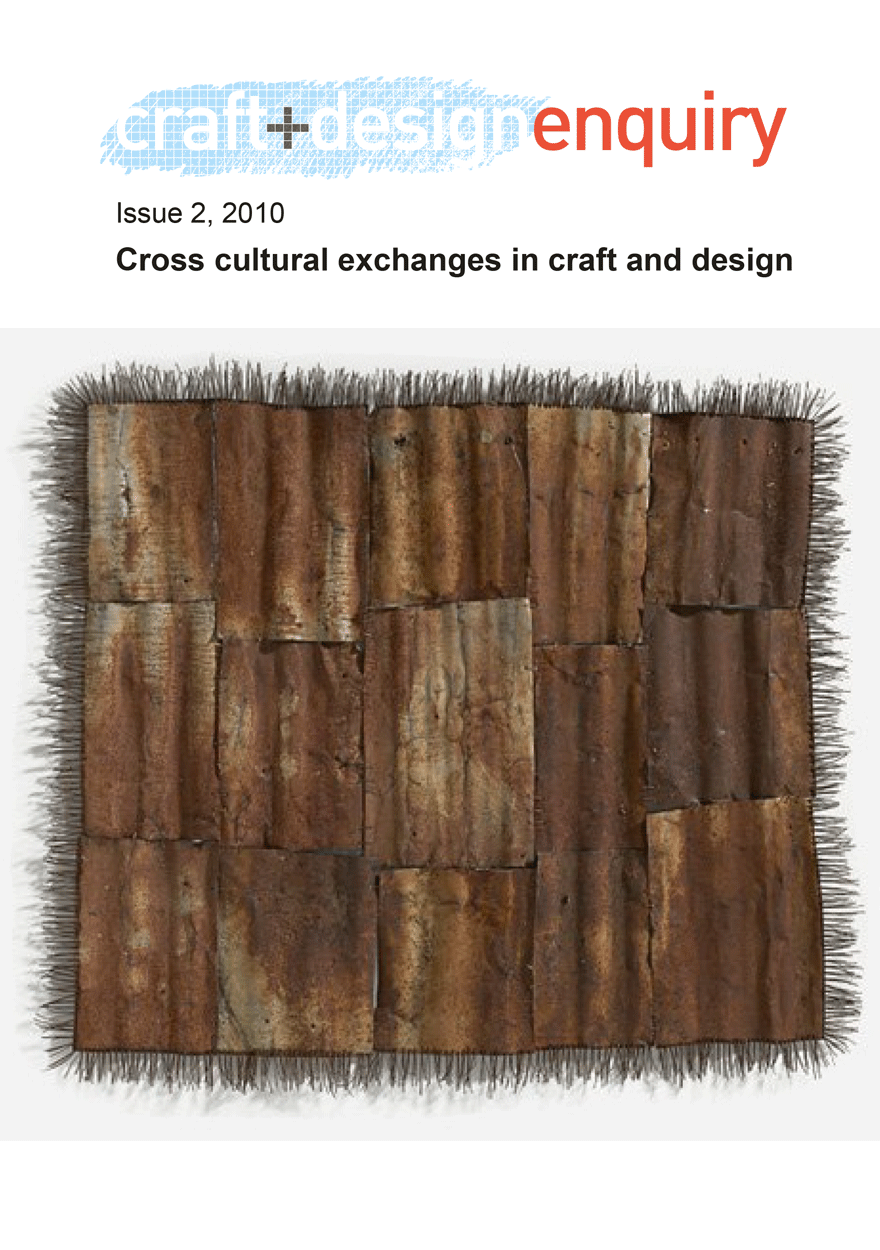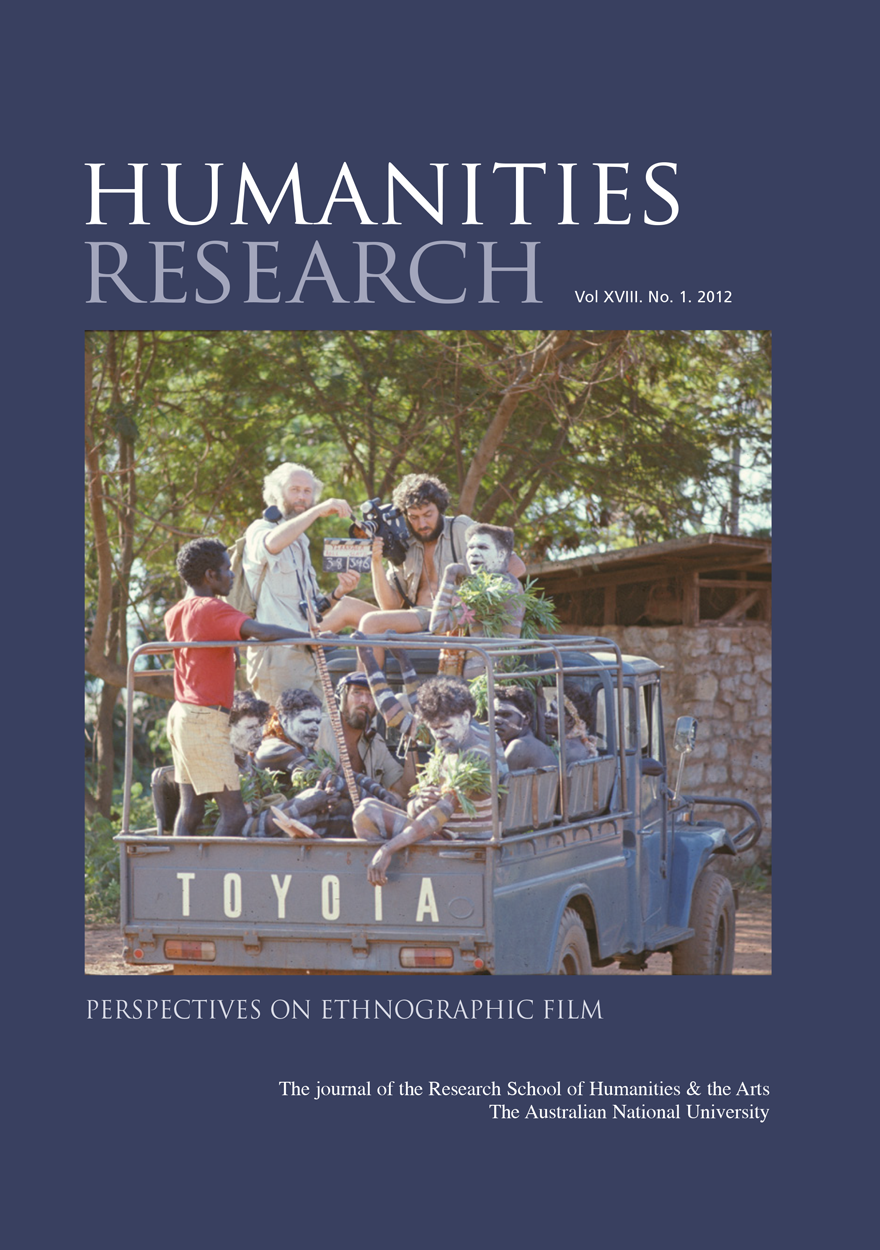Search titles
Displaying results 101 to 110 of 160.

craft + design enquiry: issue 2, 2010 »
Cross cultural exchanges in craft and design
Edited by: Louise Hamby
Publication date: December 2012
craft + design enquiry is an open-access, peer-reviewed journal promoting and disseminating research excellence generated by and about the craft and design sector. craft + design enquiry investigates the contribution that contemporary craft and design makes to society, establishing a dialogue between craft and design practice and cultural, social and environmental concerns. It includes submissions from across the field of craft and design from artists and practitioners, curators, historians, art and cultural theorists, educationalists, museum professionals, philosophers, scientists and others with a stake in the future developments of craft and design.
Download for free
Not available for purchase

craft + design enquiry: issue 1, 2009 »
Migratory Practices
Publication date: December 2012
craft + design enquiry is an open-access, peer-reviewed journal promoting and disseminating research excellence generated by and about the craft and design sector. craft + design enquiry investigates the contribution that contemporary craft and design makes to society, establishing a dialogue between craft and design practice and cultural, social and environmental concerns. It includes submissions from across the field of craft and design from artists and practitioners, curators, historians, art and cultural theorists, educationalists, museum professionals, philosophers, scientists and others with a stake in the future developments of craft and design.
Download for free
Not available for purchase

Taking the High Ground »
The archaeology of Rapa, a fortified island in remote East Polynesia
Edited by: Atholl Anderson, Douglas J. Kennett
Publication date: November 2012
This volume brings the remote and little known island of Rapa firmly to the forefront of Polynesian archaeology. Thirteen authors contribute 14 chapters, covering not only the basic archaeology of coastal sites, rock shelters, and fortifications, but faunal remains, agricultural development, and marine exploitation. The results, presented within a chronology framed by Bayesian analysis, are set against a background of ethnohistory and ethnology. Highly unusual in tropical Polynesian archaeology are descriptions of artefacts of perishable material. Taking the High Ground provides important insights into how a group of Polynesian settlers adapted to an isolated and in some ways restrictive environment.

Humanities Research: Volume XVIII. No. 1. 2012 »
Perspectives on Ethnographic Film
Edited by: Pip Deveson, Natasha Fijn
Publication date: November 2012
Humanities Research is an internationally peer-reviewed journal published by the Research School of Humanities at The Australian National University. The Research School of Humanities came into existence in January 2007 and consists of the Humanities Research Centre, Centre for Cross-Cultural Research, National Europe Centre and Australian National Dictionary Centre. Launched in 1997, issues are thematic with guest editors and address important and timely topics across all branches of the humanities.
This volume of Humanities Research features an enhanced epub: a downloadable ebook format with embedded video and audio files.
Download for free
Not available for purchase

An Otago Storeman in Solomon Islands »
The diary of William Crossan, copra trader, 1885–86
Edited by: Tim Bayliss-Smith, Judith A. Bennett
Publication date: October 2012
An Otago Storeman in Solomon Islands reaches from inland South Island of New Zealand across to the Solomon Islands during the 1880s. William Crossan’s Otago experience as a versatile storeman with a solid work ethic helped him survive on the Melanesian frontier where he encountered conflicting clans, cannibalism, cheating traders, and co-operative entrepreneurial big men. His diary provides many glimpses into Makiran society as it encountered new ideas, new employment, and western technology. It is a welcome addition to the sparse record of these cryptic copra traders seeking fortunes on the cusp of indigenous tradition and incoming colonialism.

Engendering Violence in Papua New Guinea »
Edited by: Margaret Jolly, Christine Stewart, Carolyn Brewer
Publication date: July 2012
This collection builds on previous works on gender violence in the Pacific, but goes beyond some previous approaches to ‘domestic violence’ or ‘violence against women’ in analysing the dynamic processes of ‘engendering’ violence in PNG. ‘Engendering’ refers not just to the sex of individual actors, but to gender as a crucial relation in collective life and the massive social transformations ongoing in PNG: conversion to Christianity, the development of extractive industries, the implanting of introduced models of justice and the law and the spread of HIV. Hence the collection examines issues of ‘troubled masculinities’ as much as ‘battered women’ and tries to move beyond the black and white binaries of blaming either tradition or modernity as the primary cause of gender violence. It relates original scholarly research in the villages and towns of PNG to questions of policy and practice and reveals the complexities and contestations in the local translation of concepts of human rights. It will interest undergraduate and graduate students in gender studies and Pacific studies and those working on the policy and practice of combating gender violence in PNG and elsewhere.

Peopled Landscapes »
Archaeological and Biogeographic Approaches to Landscapes
Edited by: Simon G. Haberle, Bruno David
Publication date: January 2012
This impressive collection celebrates the work of Peter Kershaw, a key figure in the field of Australian palaeoenvironmental reconstruction. Over almost half a century his research helped reconceptualize ecology in Australia, creating a detailed understanding of environmental change in the Late Pleistocene and Holocene. Within a biogeographic framework one of his exceptional contributions was to explore the ways that Aboriginal people may have modified the landscape through the effects of anthropogenic burning. These ideas have had significant impacts on thinking within the fields of geomorphology, biogeography, archaeology, anthropology and history. Papers presented here continue to explore the dynamism of landscape change in Australia and the contribution of humans to those transformations. The volume is structured in two sections. The first examines evidence for human engagement with landscape, focusing on Australia and Papua New Guinea but also dealing with the human/environmental histories of Europe and Asia. The second section contains papers that examine palaeoecology and present some of the latest research into environmental change in Australia and New Zealand. Individually these papers, written by many of Australia’s prominent researchers in these fields, are significant contributions to our knowledge of Quaternary landscapes and human land use. But Peopled Landscapes also signifies the disciplinary entanglement that is archaeological and biogeographic research in this region, with archaeologists and environmental scientists contributing to both studies of human land use and palaeoecology. Peopled Landscapes reveals the interdisciplinary richness of Quaternary research in the Australasian region as well as the complexity and richness of the entangled environmental and human pasts of these lands.
— Prof. Peter Hiscock, The Australian National University

Land and Life in Timor-Leste »
Ethnographic Essays
Edited by: Andrew McWilliam, Elizabeth G. Traube
Publication date: December 2011
Following the historic 1999 popular referendum, East Timor emerged as the first independent sovereign nation of the 21st Century. The years since these momentous events have seen an efflorescence of social research across the country drawn by shared interests in the aftermath of the resistance struggle, the processes of social recovery and the historic opportunity to pursue field-based ethnography following the hiatus of research during 24 years of Indonesian rule (1975-99).
This volume brings together a collection of papers from a diverse field of international scholars exploring the multiple ways that East Timorese communities are making and remaking their connections to land and places of ancestral significance. The work is explicitly comparative and highlights the different ways Timorese language communities negotiate access and transactions in land, disputes and inheritance especially in areas subject to historical displacement and resettlement. Consideration is extended to the role of ritual performance and social alliance for inscribing connection and entitlement. Emerging through analysis is an appreciation of how relations to land, articulated in origin discourses, are implicated in the construction of national culture and differential contributions to the struggle for independence. The volume is informed by a range of Austronesian cultural themes and highlights the continuing vitality of customary governance and landed attachment in Timor-Leste.

Law's Anthropology »
From ethnography to expert testimony in native title
Authored by: Paul Burke
Publication date: November 2011
Anthropologists have been appearing as key expert witnesses in native title claims for over 20 years. Until now, however, there has been no theoretically-informed, detailed investigation of how the expert testimony of anthropologists is formed and how it is received by judges. This book examines the structure and habitus of both the field of anthropology and the juridical field and how they have interacted in four cases, including the original hearing in the Mabo case. The analysis of background material has been supplemented by interviews with the key protagonists in each case. This allows the reader a unique, insider’s perspective of the courtroom drama that unfolds in each case. The book asks, given the available ethnographic research, how will the anthropologist reconstruct it in a way that is relevant to the legal doctrine of native title when that doctrine gives a wide leeway for interpretation on the critical questions: what is the relevant grouping, what can be counted as a traditional law and when has there been too much change of tradition? How will such evidence be received by judges who are becoming increasingly sceptical about experts tailoring their evidence to suit the party which called them? This book answers these questions by assuming that there is more at stake here than the mere performance of roles. Rather, there is a complex interaction of distinct social fields each with its own habitus, and individual actors are engaged in an active and constructive agency, however subtle, which the painstaking research for this book uncovers.

Pacific Island Heritage »
Archaeology, Identity & Community
Edited by: Jolie Liston, Geoffrey Clark, Dwight Alexander
Publication date: November 2011
‘This volume emerges from a ground-breaking conference held in the Republic of Palau on cultural heritage in the Pacific. It includes bold investigations of the role of cultural heritage in identity-making, and the ways in which community engagement informs heritage management practices. This is the first broad and detailed investigation of the unique and irreplaceable cultural heritage of the Pacific from a heritage management perspective. It identifies new trends in research and assesses relationships between archaeologists, heritage managers and local communities. The methods which emerge from these relationships will be critical to the effective management of heritage sites in the 21st century. A wonderful book which emerges from an extraordinary conference. Essential reading for cultural heritage managers, archaeologists and others with an interest in caring for the unique cultural heritage of the Pacific Islands.’
— Professor Claire Smith, President World Archaeological Congress



